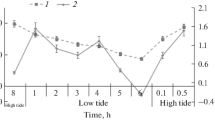Abstract
Thallus segments of Fucus serratus L. and F. vesiculosus L. (Phaeophyceae, Fucales) were transferred into seawater media with a salinity range from 32.65 to 2.25‰ and maintained for at least 2 weeks. Several parameters of chemical composition as well as rates of photosynthetic and respiratory oxygen exchange, 14C-assimilate patterns, and release of 14C-assimilates into the culture medium have been investigated. Compared to controls, in both species dry weight, ash, chloride, and mannitol contents distinctly decline proportionally to reduction of salinity in the incubation media, whereas content of total N (in terms of protein content) remarkably increase. Respiratory O2-consumption is markedly increased at lower salinities, whereas rate of photosynthetic O2-evolution shows some depression. Relatively little effects of salinity changes are observed in distribution of photosynthetically assimilated 14C among the major groups of photosynthates. Release of 14C-assimilates into the incubation medium never exceeds 2% of total 14C-uptake, but is stimulated in media of reduced salt content. The results are discussed with emphasis on phenomena of long-term adaptation and osmoregulation in the marine fucoid species.
Similar content being viewed by others
Literature Cited
Cameron, M.C., A.G. Ross and E.G.V. Percival: Routine estimation of mannitol, alginic acid, and combined fucose in seaweeds. J. Soc. chem. Ind., Lond. 67, 161–164 (1948)
Green, E.J. and D.E. Carritt: New tables of oxygen saturation of seawater. J. mar. Res. 25, 140–147 (1967)
Haug, A. and B. Larsen: Chemical composition of the brown alga Ascophyllum nodosum (L.) Le Jol. Nature, Lond. 181, p. 1224 (1958a)
——: Influence of habitat on the chemical composition of Ascophyllum nodosum. Nature, Lond. 181, p. 1225 (1958b)
Hellebust, J.A.: Osmoregulation. A. Rev. Pl. Physiol. 27, 485–505 (1976)
Hoffmann, C.: Die Atmung der Meeresalgen und ihre Beziehung zum Salzgehalt. Jb. wiss. Bot. 71, 214–268 (1929)
Höfler, K.: Hypotonietod und osmotische Resistenz einiger Rotalgen. Öst. bot. z. 80, 51–71 (1931)
Kesseler, H.: Beziehungen zwischen Atmung und Turgorregulation von Chaetomorpha linum in Abhängigkeit von Salzgehaltsänderungen und spezifischen Ionenwirkungen. Helgoländer wiss. Meeresunters. 10, 73–90 (1962)
Kirst, G.O.: Beziehungen zwischen Mannitkonzentration und osmotischer Belastung bei der Brackwasseralge Platymonas subcordiformis Hazen. Z. PflPhysiol. 76, 316–325 (1975)
Kremer, B.P.: Untersuchungen zur Biochemie und Physiologie von Mannit in benthischen marinen Algen, Dissertation, Bonn 1973
—: Mannitmetabolismus in der marinen Braunalge Fucus serratus. Z. PflPhysiol. 74, 255–263 (1975a)
—: Physiologisch-chemische Charakteristik verschiedener Thallusbereiche von Fucus serratus. Helgoländer wiss. Meeresunters. 27, 115–127 (1975b)
—: Distribution and biochemistry of alditols in the genus Pelvetia (Phaeophyceae, Fucales). Br. phycol. J. 11, 239–243 (1976)
— and K. Schmitz: CO2-Fixierung und Stofftransport in benthischen marinen Algen. IV. Zur 14CO2-Assimilation einiger litoraler Braunalgen im submersen und emersen Zustand. Z. PflPhysiol. 68, 357–363 (1973)
Moebus, K. and K.M. Johnson: Exudation of dissolved organic carbon by brown algae. Mar. Biol. 26, 117–125 (1974)
Munda, I.: Kulturversuche mit Ascophyllum nodosum (L.) Le Jol. und Fucus vesiculosus L. in Medien von verschiedenem Salzgehalt. Botanica mar. 5, 84–95 (1963)
—: Observations on variation in form and chemical composition of Fucus ceranoides L. Nova Hedwigia 8, 403–414 (1964a)
—: Water and electrolyte exchange in the brown algae Ascophyllum nodosum (L.) Le Jol., Fucus vesiculosus L. and Fucus ceranoides L. Botanica mar. 6, 158–188 (1964b)
—: Der Einfluß der Salinität auf die chemische Zusammensetzung, das Wachstum und die Fruktifikation einiger Fucaceen. Nova Hedwigia 13, 471–508 (1967)
Munda, I. Differences in amino acid composition of estuarine and marine fucoids. Aquat. Bot. press
Nellen, U.R.: Über den Einfluß des Salzgehalts auf die photosynthetische Leistung verschiedener Standortformen von Delesseria sanguinea und Fucus serratus. Helgoländer wiss. Meeresunters. 13, 288–313 (1966)
Ogata, E. and T. Matsui: Photosynthesis in several marine plants of Japan as affected by salinity, drying and pH with attention to their growth habitats. Botanica mar. 8, 199–217 (1965)
Schwenke, H.: Über die Salzgehaltsresistenz einiger Rotalgen der Kieler Bucht. Kieler Meeresforsch. 14, 11–22 (1958)
—: Neuere Erkenntnisse über die Beziehungen zwischen den Lebensfunktionen mariner Pflanzen und dem Salzgehalt des Meer- und Brackwassers. Kieler Meeresforsch. 16, 28–47 (1960)
Author information
Authors and Affiliations
Additional information
Communicated by O. Kinne, Hamburg
Rights and permissions
About this article
Cite this article
Munda, I.M., Kremer, B.P. Chemical composition and physiological properties of fucoids under conditions of reduced salinity. Mar. Biol. 42, 9–15 (1977). https://doi.org/10.1007/BF00392009
Accepted:
Issue Date:
DOI: https://doi.org/10.1007/BF00392009




